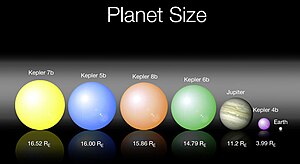Friedel oscillations
Template:Good article Template:Planetbox begin Template:Planetbox image Template:Planetbox star Template:Planetbox character Template:Planetbox orbit Template:Planetbox discovery Template:Planetbox end
Kepler-4b, initially known as KOI 7.01, is an extrasolar planet first detected as a transit by the Kepler spacecraft. Its radius and mass are similar to that of Neptune; however, due to its proximity to its host star, it is substantially hotter than any planet in the Solar System.[1][2] The planet's discovery was announced on January 4, 2010 in Washington, D.C. along with four other planets that were initially detected by the Kepler spacecraft and subsequently confirmed by telescopes at the W.M. Keck Observatory.
Nomenclature and history
Kepler-4b was named because it was the first planet discovered in the orbit of its star, Kepler-4. The star was, in turn, named for the Kepler Mission, a NASA satellite whose purpose is to discover Earth-like planets in a section of the sky between constellations Cygnus and Lyra using the transit method. Using this method, Kepler notes small and steady decreases in a star's brightness that are measured as a planet crosses in front of it.[3] Initially, Kepler-4b was detected as a transit event by the Kepler telescope and considered a Kepler Object of Interest with the designation KOI 7.01.[4]
Subsequent radial velocity measurements by the High Resolution Echelle Spectrometer on the telescopes of W.M. Keck Observatory confirmed the planetary nature of the transit event and established a mass estimate for the planet.[5] The planet's existence was announced on January 4, 2010 along with four other planets detected by Kepler: Kepler-5b, 6b, 7b and 8b[2] at the 215th meeting of the American Astronomical Society in Washington, D.C.[6]
Host star
Mining Engineer (Excluding Oil ) Truman from Alma, loves to spend time knotting, largest property developers in singapore developers in singapore and stamp collecting. Recently had a family visit to Urnes Stave Church. Kepler-4 is located within the Draco constellation on the sky, and is approximately 550 parsecs from our solar system. It has an effective temperature almost identical to the Sun at 5857 Kelvin, but a mass and radius that are somewhat larger than the sun: respectively, 1.223 and 1.487 . The star is thought to be around 4.5 billion years old, and at or very near the end of its main-sequence hydrogen burning phase. In several tens of millions of years it will likely become a subgiant star.[5]
Characteristics
Kepler-4b orbits its host star in 3.213 days at a distance of 0.046 AU.[5] This places it almost 10 times closer to its star than Mercury is to the Sun. Consequently, Kepler-4b is thought to be extremely hot, with an equilibrium temperature greater than 1700 Kelvin (2600 Fahrenheit).[7] The planet is estimated to be 25 times more massive than the Earth with a radius that is 4 times greater than the Earth.[5] This makes it similar to Neptune in terms of size and mass, but with a temperature that is not comparable to any planet in our solar system (Venus, the hottest planet is only 735 Kelvin). Kepler-4b's eccentricity was assumed to be 0, however an independent reanalysis of the discovery data found a value of 0.25 ± 0.12.[7]

See also
References
43 year old Petroleum Engineer Harry from Deep River, usually spends time with hobbies and interests like renting movies, property developers in singapore new condominium and vehicle racing. Constantly enjoys going to destinations like Camino Real de Tierra Adentro.
External links
- ↑ Cite error: Invalid
<ref>tag; no text was provided for refs nameddatatable - ↑ 2.0 2.1 Cite error: Invalid
<ref>tag; no text was provided for refs namedsciencenews - ↑ Template:Cite web
- ↑ Cite error: Invalid
<ref>tag; no text was provided for refs namedBorucki2011 - ↑ 5.0 5.1 5.2 5.3 Cite error: Invalid
<ref>tag; no text was provided for refs namedBorucki2010 - ↑ Template:Cite web
- ↑ 7.0 7.1 Cite error: Invalid
<ref>tag; no text was provided for refs namedKipping2010

